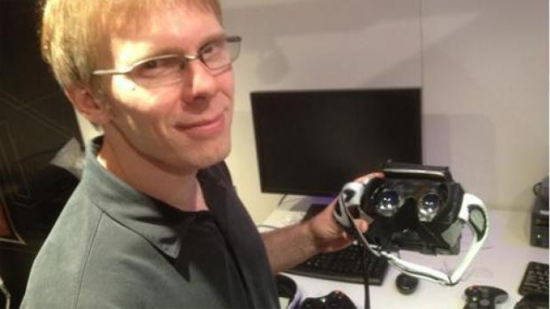VR’s going to happen. It just is.
The news today that John Carmack’s joining Oculus as CTO, Chief Technology Officer, is a little bit mind-blowing. Carmack’s role in the PC games industry is part prophet, part soothsayer. His intellect and experience allows him a very clear vision of what’s next. What will work, and what won’t.
Now, Carmack has decided that creating VR is the most important thing he could be working on right now.
Carmack’s been leading the charge for VR for some time. Some of his expertise has already been put to work in the Oculus headset: including low-latency motion sensors derived from rocket parts. And, he helped get the word out about the possibilities that Oculus represented by demoing the headset at E3 with Doom BFG Edition.
During his QuakeCon keynote this weekend, Carmack explained that pushing the envelope graphically simply isn’t a feasible route for game developers to pursue; that it’s new mechanics and ways to play that matter. His new role at Oculus fits perfectly into that.
The technical challenges that home VR face are immense. There’s latency, and the promise of fixing the simulation sickness that accompanies prolonged VR sessions. The second is the sheer raw performance required to generate VR 3D: producing two very high definition images (to avoid visible pixels VR headsets will have to include screens with resolutions higher than the current highest end mobile phones, and way beyond the 1080p desktop screens). There’s focusing; and adjusting the image and calibration for gamers differing clarity of vision. There’s control: just a few days with the Oculus Dev Kit will convince you that the mouse and keyboard or joypad probably won’t cut it for full 3D experiences.
But most of all: there’s the art.
I’ve met and interviewed John a couple of times as a journalist. He’s an astounding interview subject: his replies and arguments articulated perfectly and precisely, without hesitation.
I have a particular memory of interviewing John at E3 in 2011 that’s a little off beat. We were tucked into a meeting room at the back of the Bethesda group. While the rest of the id team were demoing Rage, he was tucked upstairs, coding on his iPad. We spent a decent amount of time talking technology, cloud gaming, the future, and code, and silicon and everything in between.
But then a thought occurred to me. That none of this means anything until you give it to an artist.
John’s face lit up.
“I’m an engineer,” he explained. “I’m given a set of resources and a set of goals and I’m trying to chart the best way to use those resources to get to some approximation of those goals. But the artists really do have their vision of what they want to get in there. The interesting thing is that it’s so far beyond my vision. That’s what differentiates the artists from the rest of us.”
That’s what’s most exciting to me. It’s not just about delivering the technology. It’s the application of technology. The end result of his work on Quake and Doom wasn’t just those games; that tech was later used for Half-Life, Call of Duty, and dozens of other games.
Oculus now have a chance at a similar trick: delivering technology game developers can and will work with to create incredible new experiences.
It’s not just about the goggles. It’s about the worlds we’ll see through them.
